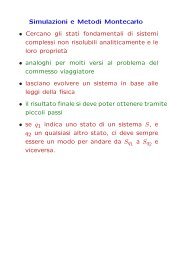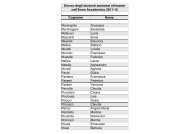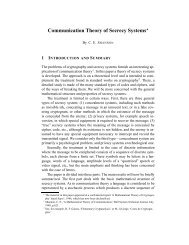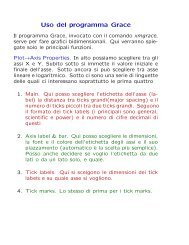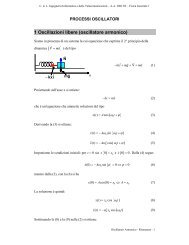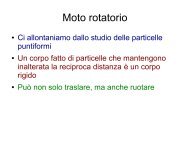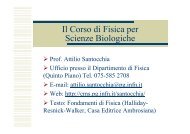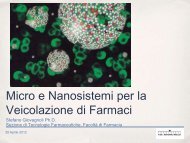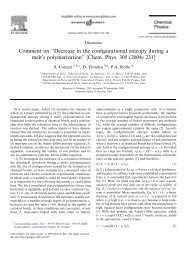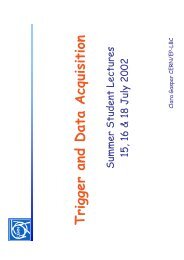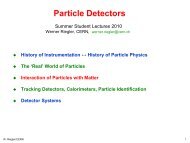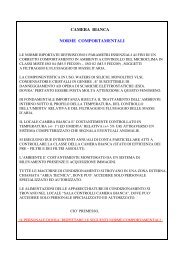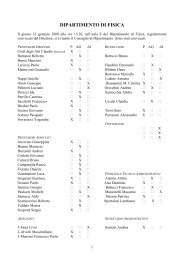Triggers For LHC Physics - Indico - Cern
Triggers For LHC Physics - Indico - Cern
Triggers For LHC Physics - Indico - Cern
Create successful ePaper yourself
Turn your PDF publications into a flip-book with our unique Google optimized e-Paper software.
<strong>Triggers</strong> <strong>For</strong> <strong>LHC</strong> <strong>Physics</strong><br />
Bryan Dahmes<br />
University of Minnesota<br />
bryan.michael.dahmes@cern.ch<br />
Bryan Dahmes (Minnesota) Summer Student Lecture Program: <strong>Triggers</strong> for <strong>LHC</strong> <strong>Physics</strong> (17-18 July 2012)<br />
1
Introduction<br />
● Some terminology<br />
● Motivation: Why do we need a trigger?<br />
● Using <strong>LHC</strong> physics to set the scale<br />
● Explanation of the Trigger components<br />
● Level 1 (L1) and High Level Trigger (HLT)<br />
● Features of ATLAS and CMS trigger system<br />
● How a trigger interfaces with an analysis<br />
● Building a trigger and discussion of strategy<br />
● Other fun (i.e. examples) with triggers<br />
Bryan Dahmes (Minnesota) Summer Student Lecture Program: <strong>Triggers</strong> for <strong>LHC</strong> <strong>Physics</strong> (17-18 July 2012)<br />
2
Terminology<br />
● Data is collected online<br />
● Collision data recorded by the detectors<br />
● Physicists analyze this data offline<br />
● Optimizing selection, estimating/modeling background,<br />
establishing limits, discovering New <strong>Physics</strong>, etc.<br />
● The <strong>LHC</strong> delivers a lot of data, which we need to<br />
first select online<br />
● The trigger is a fast online filter that selects the<br />
useful events for offline analysis<br />
Bryan Dahmes (Minnesota) Summer Student Lecture Program: <strong>Triggers</strong> for <strong>LHC</strong> <strong>Physics</strong> (17-18 July 2012)<br />
3
Why Do We Need a Trigger?<br />
● Save the most interesting events for later<br />
● Simple trigger in e + e - colliders: Take (nearly)<br />
everything<br />
Low cross section<br />
Low rate<br />
Bryan Dahmes (Minnesota) Summer Student Lecture Program: <strong>Triggers</strong> for <strong>LHC</strong> <strong>Physics</strong> (17-18 July 2012)<br />
4
A Few <strong>LHC</strong> Facts<br />
20 MHz<br />
25 nsec (design)<br />
between proton bunches<br />
Multiple collisions<br />
per crossing<br />
Bryan Dahmes (Minnesota) Summer Student Lecture Program: <strong>Triggers</strong> for <strong>LHC</strong> <strong>Physics</strong> (17-18 July 2012)<br />
5
The <strong>LHC</strong>: Setting the Scale<br />
14 TeV, 10 34 cm -2 sec -1<br />
Process σ (nb)<br />
Inelastic 10 8<br />
-<br />
Production<br />
rates (Hz)<br />
10 9<br />
bb 5×10 5 5×10 6<br />
W → ℓν 15 150<br />
Z → ℓℓ 2 20<br />
-<br />
tt 1 10<br />
Z' (1 TeV) 0.05 0.5<br />
~~<br />
gg (1 TeV) 0.05 0.5<br />
Higgs (100 GeV) 0.05 0.5<br />
Higgs (500 GeV) 10 -3 10 -2<br />
Bryan Dahmes (Minnesota) Summer Student Lecture Program: <strong>Triggers</strong> for <strong>LHC</strong> <strong>Physics</strong> (17-18 July 2012)<br />
6
Roughly one<br />
light (125 GeV) Higgs<br />
for every 10,000,000,000<br />
pp interactions<br />
New <strong>Physics</strong> Rate<br />
Bryan Dahmes (Minnesota) Summer Student Lecture Program: <strong>Triggers</strong> for <strong>LHC</strong> <strong>Physics</strong> (17-18 July 2012)<br />
7
Drop of water: Roughly 0.1 mL<br />
1 in 10,000,000,000:<br />
Like looking for a single drop<br />
of water from the Jet d'Eau<br />
over 30 minutes<br />
Perspective<br />
Jet d'Eau: 500 L/sec<br />
Bryan Dahmes (Minnesota) Summer Student Lecture Program: <strong>Triggers</strong> for <strong>LHC</strong> <strong>Physics</strong> (17-18 July 2012)<br />
8
Keeping Events<br />
● “New <strong>Physics</strong>” is rare, and thus buried under<br />
lots of “uninteresting” events<br />
● Do we really want to keep every event?<br />
● This would be the only way to be sure<br />
we don't miss anything<br />
● No, for (at least) two reasons<br />
● We would mostly be saving “background” events<br />
● But also...<br />
Bryan Dahmes (Minnesota) Summer Student Lecture Program: <strong>Triggers</strong> for <strong>LHC</strong> <strong>Physics</strong> (17-18 July 2012)<br />
9
Keeping Events<br />
● We can't save everything!<br />
● Event size: about 1 MB<br />
● Event reconstruction time:<br />
● 30 sec – 1 minute<br />
● At a data rate of O(100 Hz)...<br />
● O(100) MB/sec<br />
● O(few) PB/year<br />
per experiment<br />
● Keeping every event<br />
● O(100000) PB/year<br />
● Too big to store<br />
● Too big to reconstruct<br />
● Too big to analyze<br />
Bryan Dahmes (Minnesota) Summer Student Lecture Program: <strong>Triggers</strong> for <strong>LHC</strong> <strong>Physics</strong> (17-18 July 2012)<br />
10
Trigger = Rejection<br />
● Problem: We must analyze AND REJECT<br />
most <strong>LHC</strong> collisions prior to storage<br />
● Solution: Trigger<br />
● Fast processing<br />
● High rejection factor: 10 4 – 10 5<br />
● High efficiency for interesting physics<br />
● If events fail the trigger, we don't save them!<br />
● Flexible<br />
● Affordable<br />
● Redundant<br />
Bryan Dahmes (Minnesota) Summer Student Lecture Program: <strong>Triggers</strong> for <strong>LHC</strong> <strong>Physics</strong> (17-18 July 2012)<br />
11
High pT e,γ<br />
Trigger Signatures<br />
High pT jets<br />
Also: Trigger on total transverse<br />
(or missing transverse) energy<br />
High pT μ<br />
Bryan Dahmes (Minnesota) Summer Student Lecture Program: <strong>Triggers</strong> for <strong>LHC</strong> <strong>Physics</strong> (17-18 July 2012)<br />
12
3 kHz<br />
Lvl-1<br />
Lvl-2<br />
Event<br />
Filter<br />
40 MHz<br />
Trigger Setup<br />
Detectors<br />
Front end pipelines<br />
100 kHz<br />
Readout buffers<br />
Switching network<br />
Processor farms<br />
Detectors<br />
Front end pipelines<br />
Readout buffers<br />
Switching network<br />
Processor farms<br />
Bryan Dahmes (Minnesota) Summer Student Lecture Program: <strong>Triggers</strong> for <strong>LHC</strong> <strong>Physics</strong> (17-18 July 2012)<br />
13<br />
Lvl-1<br />
High Level<br />
Trigger<br />
O(100) Hz Reduce the data<br />
volume in stages<br />
40 MHz<br />
100 kHz<br />
O(100) Hz
Trigger Setup<br />
● Level 1: Custom hardware and firmware<br />
● Reduces the rate from 40 MHz to 100 kHz<br />
● Advantage: speed<br />
● Level 2: Computing farm (software)<br />
● Further reduces the rate to a few kHz<br />
● Reconstruct a region surrounding the L1 trigger object<br />
● Advantage: Further rejection, still relatively fast<br />
● Level 3: Computing farm (software)<br />
● Store events passing final selection for offline analysis<br />
● Advantage: The best reconstruction<br />
Bryan Dahmes (Minnesota) Summer Student Lecture Program: <strong>Triggers</strong> for <strong>LHC</strong> <strong>Physics</strong> (17-18 July 2012)<br />
14
Trigger Setup<br />
● Level 1: Custom hardware and firmware<br />
● Reduces the rate from 40 MHz to 100 kHz<br />
● Advantage: speed<br />
● Level 2: Computing farm (software)<br />
● Further reduces the rate to a few kHz<br />
● Reconstruct a region surrounding the L1 trigger object<br />
● Advantage: Further rejection, still relatively fast<br />
● Level 3: Computing farm (software)<br />
● Store events passing final selection for offline analysis<br />
● Advantage: The best reconstruction<br />
High Level Trigger<br />
Bryan Dahmes (Minnesota) Summer Student Lecture Program: <strong>Triggers</strong> for <strong>LHC</strong> <strong>Physics</strong> (17-18 July 2012)<br />
15
Higgs Selection<br />
using the Trigger<br />
Level 1:<br />
Not all<br />
information available,<br />
coarse granularity<br />
Trigger Example: Higgs<br />
Bryan Dahmes (Minnesota) Summer Student Lecture Program: <strong>Triggers</strong> for <strong>LHC</strong> <strong>Physics</strong> (17-18 July 2012)<br />
16
Higgs Selection<br />
using the Trigger<br />
Level 2:<br />
Improved reconstruction<br />
techniques, improved<br />
ability to reject events<br />
Trigger Example: Higgs<br />
Bryan Dahmes (Minnesota) Summer Student Lecture Program: <strong>Triggers</strong> for <strong>LHC</strong> <strong>Physics</strong> (17-18 July 2012)<br />
17
Higgs Selection<br />
using the Trigger<br />
Level 3:<br />
High quality<br />
reconstruction<br />
algorithms using<br />
information from<br />
all detectors<br />
Trigger Example: Higgs<br />
Bryan Dahmes (Minnesota) Summer Student Lecture Program: <strong>Triggers</strong> for <strong>LHC</strong> <strong>Physics</strong> (17-18 July 2012)<br />
18
L1 Trigger<br />
● Custom electronics designed to make very fast decisions<br />
● Application-Specified Integrated Circuits (ASICs)<br />
● Field Programmable Gate Arrays (FPGAs)<br />
● Possible to change algorithms after installation<br />
● Must be able to cope with input rate of 40 MHz<br />
● Otherwise trigger wasting time (and money)<br />
as new events keep arriving<br />
● Event buffering is expensive, too<br />
● L1 Trigger: Pipeline<br />
● Process many events at once<br />
● Parallel processing of different inputs as much as possible<br />
Bryan Dahmes (Minnesota) Summer Student Lecture Program: <strong>Triggers</strong> for <strong>LHC</strong> <strong>Physics</strong> (17-18 July 2012)<br />
19
Less than 1 μs:<br />
On-detector<br />
processing,<br />
cables to<br />
underground<br />
control room<br />
L1 Trigger Latency<br />
Roughly 1 μs<br />
spent on Processing<br />
and Decision Logic<br />
Less than 1 μs:<br />
Cables back to<br />
detector in hall,<br />
distribution to<br />
detector front-ends<br />
Bryan Dahmes (Minnesota) Summer Student Lecture Program: <strong>Triggers</strong> for <strong>LHC</strong> <strong>Physics</strong> (17-18 July 2012)<br />
20
L1 Calorimeter Trigger<br />
Example: ATLAS e/γ trigger<br />
● Sum energy in calorimeter<br />
cells into towers<br />
● Search in 4x4 tower<br />
overlapping, sliding window<br />
● Cluster: local maximum<br />
within the window<br />
Signatures for several physics objects<br />
● Electrons, photons (EM only)<br />
● Jets, τ leptons (EM+Had)<br />
● Sum ET, missing ET<br />
Bryan Dahmes (Minnesota) Summer Student Lecture Program: <strong>Triggers</strong> for <strong>LHC</strong> <strong>Physics</strong> (17-18 July 2012)<br />
21
L1 Calorimeter Trigger<br />
L1 Jets (CMS)<br />
● Search in large 12x12 region<br />
● Centering the L1 jet: highest<br />
ET 4x4 region<br />
L1 Tau (CMS)<br />
● Search in a narrow 2x2 region<br />
● Jet = τ if no τ veto set<br />
Offline jet<br />
Bryan Dahmes (Minnesota) Summer Student Lecture Program: <strong>Triggers</strong> for <strong>LHC</strong> <strong>Physics</strong> (17-18 July 2012)<br />
22
Curved pT-dependent<br />
muon path requires<br />
fast pattern recognition<br />
L1 Muon Trigger<br />
100 GeV<br />
Rough estimate of<br />
muon pT determined from<br />
bending in magnetic field<br />
50 GeV<br />
25 GeV<br />
15 GeV<br />
6.5 GeV<br />
5 GeV<br />
CMS, η = 0 (simulation)<br />
Bryan Dahmes (Minnesota) Summer Student Lecture Program: <strong>Triggers</strong> for <strong>LHC</strong> <strong>Physics</strong> (17-18 July 2012)<br />
23
L1 Muon Trigger<br />
CMS Muon Trigger selects<br />
best four candidates<br />
per bunch crossing<br />
Bryan Dahmes (Minnesota) Summer Student Lecture Program: <strong>Triggers</strong> for <strong>LHC</strong> <strong>Physics</strong> (17-18 July 2012)<br />
24
Putting Everything Together<br />
● We still need a global decision<br />
● We have the information, does the event pass?<br />
● Decision needs to be made quickly<br />
Large Detectors<br />
Small time/space<br />
(25 nsec, 7.5 m)<br />
between collisions<br />
Bryan Dahmes (Minnesota) Summer Student Lecture Program: <strong>Triggers</strong> for <strong>LHC</strong> <strong>Physics</strong> (17-18 July 2012)<br />
25
ATLAS Central Trigger<br />
Central/Global Trigger<br />
● Muon and Calorimeter L1 outputs<br />
sent to L1 Central/Global Trigger<br />
● Responsibilities of CTP/GT<br />
● Time-synchronize inputs<br />
● Combine inputs, apply trigger logic<br />
● Apply prescales<br />
● Busy (deadtime) logic<br />
● Issue L1 decision<br />
Bryan Dahmes (Minnesota) Summer Student Lecture Program: <strong>Triggers</strong> for <strong>LHC</strong> <strong>Physics</strong> (17-18 July 2012)<br />
26
Dead Time<br />
● Sending information from detector to DAQ takes time<br />
● Too many events at once can clog the system,<br />
prevent new data from being analyzed<br />
● L1 trigger rules control the flow of data<br />
● Dead time in short time<br />
window surrounding an<br />
event accepted by L1<br />
● Prevent too many<br />
triggers in longer<br />
time periods<br />
● Inefficiency at the<br />
percent level,<br />
but unbiased<br />
Example of deadtime<br />
due to detector readout issues<br />
Bryan Dahmes (Minnesota) Summer Student Lecture Program: <strong>Triggers</strong> for <strong>LHC</strong> <strong>Physics</strong> (17-18 July 2012)<br />
27
L1 Track Trigger?<br />
● L1 triggers use muon systems and calorimeters<br />
● Many thousands of channels, fast pattern recognition<br />
● Tracking detectors<br />
● (Tens of) Millions of channels, complicated track reconstruction<br />
● Transmitting all data at 40 MHz prohibitive<br />
● <strong>LHC</strong> experiments currently run without tracking at L1<br />
● Tracking at L1 expected for S<strong>LHC</strong> upgrades<br />
Bryan Dahmes (Minnesota) Summer Student Lecture Program: <strong>Triggers</strong> for <strong>LHC</strong> <strong>Physics</strong> (17-18 July 2012)<br />
28
Upgrade? But We Just Started!<br />
● Problem: We know that the rate of<br />
interesting physics is low<br />
● Otherwise, we would have found it already!<br />
● We need to produce many more collisions to quantify<br />
the new physics, whatever it looks like<br />
● Solution: Increase the collision rate<br />
● More bunches (50→25 nsec spacing)<br />
● More protons per bunch, tighter bunches<br />
● More crossings, more collisions per crossing<br />
● These extra collisions produce...<br />
Bryan Dahmes (Minnesota) Summer Student Lecture Program: <strong>Triggers</strong> for <strong>LHC</strong> <strong>Physics</strong> (17-18 July 2012)<br />
29
Pileup<br />
CMS Simulation: 300 GeV H→ZZ→eeμμ at various instantaneous luminosities<br />
10 32 cm -2 s -1<br />
10 34 cm -2 s -1<br />
10 33 cm -2 s -1<br />
10 35 cm -2 s -1<br />
Bryan Dahmes (Minnesota) Summer Student Lecture Program: <strong>Triggers</strong> for <strong>LHC</strong> <strong>Physics</strong> (17-18 July 2012)<br />
30
● <strong>LHC</strong> Design:<br />
20 collisions per crossing<br />
● Today: Average<br />
15-20 collisions per crossing<br />
● Multiple pp collisions per crossing<br />
produce lots of low-energy<br />
background tracks<br />
● Tracks from interesting process<br />
should still be isolated<br />
Pileup<br />
Z→μμ with 25 reconstructed vertices<br />
Bryan Dahmes (Minnesota) Summer Student Lecture Program: <strong>Triggers</strong> for <strong>LHC</strong> <strong>Physics</strong> (17-18 July 2012)<br />
31
L1 Trigger at High(er) Collision Rate<br />
● L1 Trigger must cope with high collision rate<br />
● Tighten trigger requirements to reject extra background<br />
● Trade-off: Possible loss of signal efficiency<br />
● Multiple collisions per crossing impacts the L1 trigger<br />
● All this was “known” already, as part of the <strong>LHC</strong> detector design<br />
● S<strong>LHC</strong>: New challenges<br />
Bryan Dahmes (Minnesota) Summer Student Lecture Program: <strong>Triggers</strong> for <strong>LHC</strong> <strong>Physics</strong> (17-18 July 2012)<br />
32
Higher Level Triggering<br />
● From L1 we expect a large rate (up to 100 kHz) of<br />
events that “might be interesting”<br />
● These events are not kept yet (rate too high for<br />
storage), but sent to the HLT for additional filtering<br />
● Massive commercial computer farm<br />
● ATLAS: L2 and L3 handled by separate computing farms<br />
● Roughly 17k CPUs that can be freely assigned to either<br />
● CMS: Single computing farm (roughly 13k CPUs)<br />
● Parallel processing, each CPU processes<br />
individual event<br />
● Resources are still limited<br />
● Offline: Full reconstruction takes seconds (minutes)<br />
● Online latency: milliseconds (input rate dependent)<br />
Bryan Dahmes (Minnesota) Summer Student Lecture Program: <strong>Triggers</strong> for <strong>LHC</strong> <strong>Physics</strong> (17-18 July 2012)<br />
33
Making a Fast HLT<br />
● HLT is composed of hundreds of trigger algorithms<br />
● Software design, so no strict limit on the number of algorithms<br />
● Each designed with a specific physics signature in mind<br />
● Algorithm speed enhanced by various checkpoints<br />
● Opportunity to reject early and save processing time<br />
L1 EM<br />
Calorimeter<br />
Reconstruction<br />
EM like?<br />
YES<br />
Track<br />
Reconstruction<br />
Electron?<br />
Bryan Dahmes (Minnesota) Summer Student Lecture Program: <strong>Triggers</strong> for <strong>LHC</strong> <strong>Physics</strong> (17-18 July 2012)<br />
34<br />
NO<br />
NO
Making a Fast HLT<br />
● All algorithms (“trigger paths”) are executed in parallel<br />
● Every trigger path is run to completion (i.e. we get yes/no)<br />
● The time to process an event depends mostly on the<br />
slowest running trigger path<br />
● Multiple checkpoints speed up processing<br />
● Run more complicated, slower, operations on fewer events<br />
...<br />
Bryan Dahmes (Minnesota) Summer Student Lecture Program: <strong>Triggers</strong> for <strong>LHC</strong> <strong>Physics</strong> (17-18 July 2012)<br />
35
Example: HLT Electrons<br />
● Start from L1 e/γ seed with sufficient ET<br />
● Reconstruct the cluster in EM Calorimeter<br />
● Is there enough<br />
energy to continue?<br />
● Does the cluster shape look like<br />
that of an electron/photon?<br />
● Make sure the cluster is<br />
not a hadron (check Hadronic<br />
Calorimeter)<br />
● Is the candidate isolated<br />
in the calorimeters?<br />
● Electrons<br />
● Is there a track matched to the cluster?<br />
● Is the electron isolated in the tracker?<br />
● Photons<br />
● Check for tracks pointing to the cluster<br />
Loose description of CMS<br />
electron/photon paths,<br />
Similar logic in ATLAS<br />
Bryan Dahmes (Minnesota) Summer Student Lecture Program: <strong>Triggers</strong> for <strong>LHC</strong> <strong>Physics</strong> (17-18 July 2012)<br />
36
Example: HLT Muons<br />
● Muons in CMS:<br />
● Starting from L1 muon<br />
candidate, refit using<br />
the muon system<br />
● Continue if sufficient pT<br />
● Combine tracker hits with<br />
muon system to get a<br />
better pT measurement<br />
● Keep the event<br />
if pT is large enough<br />
● Muons in ATLAS:<br />
● At Level 2, using detector information from the region of interest,<br />
assign muon pT based on fast look up tables<br />
● Extrapolate to the collision point and find the associated track<br />
● Is the muon isolated in the tracker, calorimeters?<br />
● Refine selection at L3, compute pT using Tracking information<br />
Bryan Dahmes (Minnesota) Summer Student Lecture Program: <strong>Triggers</strong> for <strong>LHC</strong> <strong>Physics</strong> (17-18 July 2012)<br />
37
The Evolution of the Trigger<br />
Example: 2010 <strong>LHC</strong> running<br />
● First collisions, luminosity<br />
of 10 27 Hz/cm 2<br />
● Initially possible to save<br />
nearly every pp collision<br />
● Very simple HLT algorithms<br />
● Pass-through of L1 triggers<br />
● And then...<br />
The trigger (L1+HLT) is<br />
by design very flexible:<br />
● Should always be able to respond<br />
to the present physics demand<br />
● And demands can change quickly!<br />
Bryan Dahmes (Minnesota) Summer Student Lecture Program: <strong>Triggers</strong> for <strong>LHC</strong> <strong>Physics</strong> (17-18 July 2012)<br />
38
Evolution of the Trigger<br />
● From March-October 2010, instantaneous<br />
luminosity increased rapidly to 10 32<br />
● 10 5 increase over roughly six months<br />
● Important to be able to adapt<br />
quickly, using tools best suited<br />
for the conditions<br />
Increase<br />
of ~10 4<br />
Burj Khalifa (828 m)<br />
Dubai, UAE<br />
Bryan Dahmes (Minnesota) Summer Student Lecture Program: <strong>Triggers</strong> for <strong>LHC</strong> <strong>Physics</strong> (17-18 July 2012)<br />
39
HLT Path Structure<br />
The simplest HLT paths:<br />
Pass-through for L1<br />
No additional selection,<br />
no bias with respect to L1<br />
Bryan Dahmes (Minnesota) Summer Student Lecture Program: <strong>Triggers</strong> for <strong>LHC</strong> <strong>Physics</strong> (17-18 July 2012)<br />
40
Increased complexity, increased time<br />
HLT Path Structure<br />
The simplest HLT paths:<br />
Pass-through for L1<br />
No additional selection,<br />
no bias with respect to L1<br />
Next Level: Confirm L1 object<br />
using higher granularity<br />
detector information<br />
Fast reconstruction techniques,<br />
improved resolution<br />
Continue adding complexity<br />
Improve quality of trigger object,<br />
approaching offline quality<br />
Bryan Dahmes (Minnesota) Summer Student Lecture Program: <strong>Triggers</strong> for <strong>LHC</strong> <strong>Physics</strong> (17-18 July 2012)<br />
41
HLT Timing<br />
Expected CMS HLT CPU Performance at 2x10 32 Hz/cm²<br />
Sample: Minimum Bias L1-skim<br />
Examine L1 information<br />
Fast accept/reject<br />
Photons, Jets,<br />
and some Muons<br />
<strong>Triggers</strong> with more<br />
intensive algorithms<br />
(e.g. Track reconstruction)<br />
Mean time is critical<br />
“Slow” events have a<br />
large impact on average time<br />
Overflow:<br />
Very intensive computation<br />
Bryan Dahmes (Minnesota) Summer Student Lecture Program: <strong>Triggers</strong> for <strong>LHC</strong> <strong>Physics</strong> (17-18 July 2012)<br />
42
Trigger designs for<br />
ATLAS/CMS<br />
reflect physics goals<br />
Trigger and DAQ<br />
<strong>LHC</strong> Experiments have much higher<br />
DAQ requirements than previous experiments<br />
Different trigger<br />
configurations<br />
for <strong>LHC</strong>b, ALICE<br />
Bryan Dahmes (Minnesota) Summer Student Lecture Program: <strong>Triggers</strong> for <strong>LHC</strong> <strong>Physics</strong> (17-18 July 2012)<br />
43
<strong>LHC</strong>b Trigger<br />
High ET/pT<br />
candidates<br />
L0<br />
(Hardware)<br />
1 MHz<br />
Inclusive+Exclusive<br />
Full Reconstruction<br />
Inclusive<br />
Partial Reconstruction<br />
Pile-up Veto<br />
HLT1 HLT2<br />
50 30 kHz 3 kHz<br />
Software<br />
Bryan Dahmes (Minnesota) Summer Student Lecture Program: <strong>Triggers</strong> for <strong>LHC</strong> <strong>Physics</strong> (17-18 July 2012)<br />
44
ALICE Central Trigger Processor<br />
Unique ALICE constraints<br />
● Low rate of Pb-Pb collisions<br />
● Very large events<br />
● Slow tracking detector (TPC)<br />
Three levels of<br />
hardware triggers<br />
Bryan Dahmes (Minnesota) Summer Student Lecture Program: <strong>Triggers</strong> for <strong>LHC</strong> <strong>Physics</strong> (17-18 July 2012)<br />
45
Trigger/DAQ Comparison<br />
Bryan Dahmes (Minnesota) Summer Student Lecture Program: <strong>Triggers</strong> for <strong>LHC</strong> <strong>Physics</strong> (17-18 July 2012)<br />
46
Summary<br />
● Very challenging to design a trigger setup for<br />
<strong>LHC</strong> conditions<br />
● Very high rate of collisions<br />
● High rejection rates, “interesting physics” efficiency,<br />
and speed required<br />
● Custom hardware at first level partially reduces the rate<br />
● Coarse granularity, but very fast<br />
● Parallel computing (massive commercial<br />
computing farm) complicated data analysis online<br />
● Trigger stages cooperate to reject uninteresting<br />
data quickly<br />
Bryan Dahmes (Minnesota) Summer Student Lecture Program: <strong>Triggers</strong> for <strong>LHC</strong> <strong>Physics</strong> (17-18 July 2012)<br />
47
<strong>Triggers</strong> <strong>For</strong> <strong>LHC</strong> <strong>Physics</strong><br />
Bryan Dahmes<br />
University of Minnesota<br />
bryan.michael.dahmes@cern.ch<br />
Bryan Dahmes (Minnesota) Summer Student Lecture Program: <strong>Triggers</strong> for <strong>LHC</strong> <strong>Physics</strong> (17-18 July 2012)<br />
48
Reminder<br />
● Very challenging to design a trigger setup for<br />
<strong>LHC</strong> conditions<br />
● Very high rate of collisions<br />
● Require high rejection rates, “interesting physics” efficiency...<br />
● ...and speed!<br />
● Custom hardware at first level partially reduces the rate<br />
● Coarse granularity, but very fast<br />
● Parallel computing (massive commercial computing farm)<br />
allows complicated data analysis online<br />
● Trigger stages (L1 through HLT) cooperate to reject<br />
uninteresting data quickly<br />
Bryan Dahmes (Minnesota) Summer Student Lecture Program: <strong>Triggers</strong> for <strong>LHC</strong> <strong>Physics</strong> (17-18 July 2012)<br />
49
Preview<br />
● What will happen today<br />
● Overview of trigger strategy, and how a good<br />
understanding of the trigger is important for analysis<br />
● Some examples of the trigger in action<br />
Bryan Dahmes (Minnesota) Summer Student Lecture Program: <strong>Triggers</strong> for <strong>LHC</strong> <strong>Physics</strong> (17-18 July 2012)<br />
50
Trigger Interface with Analysis<br />
● As far as the data is<br />
concerned, the trigger<br />
is the first step towards<br />
publication<br />
● But the order is a bit<br />
backward for physicists<br />
● Why?<br />
Bryan Dahmes (Minnesota) Summer Student Lecture Program: <strong>Triggers</strong> for <strong>LHC</strong> <strong>Physics</strong> (17-18 July 2012)<br />
51
Trigger Interface with Analysis<br />
● Physicists start with an<br />
analysis idea<br />
● Determine what you want to look<br />
for (i.e. where you want to go)<br />
● Then figure out how to<br />
select the data<br />
● There is little point in trying to do<br />
an analysis if every “interesting”<br />
event fails the trigger<br />
● Want to build a trigger that has<br />
loose requirements that you<br />
tighten up offline<br />
● Design a trigger to meet<br />
analysis goals, but...<br />
Bryan Dahmes (Minnesota) Summer Student Lecture Program: <strong>Triggers</strong> for <strong>LHC</strong> <strong>Physics</strong> (17-18 July 2012)<br />
52
Competing for Data<br />
● There are hundreds to thousands of physicists on an<br />
<strong>LHC</strong> collaboration<br />
● All are competing for the same resources<br />
● Only O(100) Hz of collision data available<br />
● At L = 10 34 , this is roughly the rate of W→ℓν production!<br />
● How do you make sure your (very important) data is<br />
kept for later analysis?<br />
● Need to meet physics needs with limited bandwidth<br />
● Cutting at the trigger level throws away data forever<br />
● Potential bias to events that you analyze<br />
● Loss of interesting data<br />
“The Trigger does not determine<br />
which <strong>Physics</strong> Model is right,<br />
only which <strong>Physics</strong> Model is left”<br />
Bryan Dahmes (Minnesota) Summer Student Lecture Program: <strong>Triggers</strong> for <strong>LHC</strong> <strong>Physics</strong> (17-18 July 2012)<br />
53
Trigger Menus<br />
<strong>Triggers</strong> are created for a specific analysis,<br />
but the <strong>Physics</strong> Goals of the experiment determine<br />
where the events can be most useful<br />
L = 8x10<br />
Jets, MET, Tau: 15%<br />
Electrons: 25%<br />
Muons: 25%<br />
“Support” <strong>Triggers</strong>: 50%<br />
29 Hz/cm2 Rate ~ 200-300 Hz (*)<br />
Trigger Menus: All triggers used<br />
to collect data for a given run period<br />
Breakdown of sample CMS trigger menus<br />
Early-Mid 2010<br />
(*) Numbers and fractions approximate,<br />
and do not account for trigger overlap<br />
L = 2x10 32 Hz/cm 2<br />
Rate ~ 300-500 Hz<br />
Jets, MET: 30%<br />
b, Tau: 15%<br />
Electrons: 25%<br />
Muons: 30%<br />
“Support” <strong>Triggers</strong>: 10%<br />
End 2010<br />
At present,<br />
roughly 500 triggers<br />
in each menu<br />
for ATLAS/CMS<br />
L = 2x1033 Hz/cm2 Rate ~ 200-300 Hz<br />
Jets, etc.: 20%<br />
Tau: 5%<br />
Electrons: 20%<br />
Muons: 20%<br />
Cross <strong>Triggers</strong>: 20%<br />
“Support” <strong>Triggers</strong>: 5%<br />
Bryan Dahmes (Minnesota) Summer Student Lecture Program: <strong>Triggers</strong> for <strong>LHC</strong> <strong>Physics</strong> (17-18 July 2012)<br />
54<br />
2011
Trigger Menus<br />
Object breakdown for present instantaneous luminosities<br />
of (nearly 7 x 10 33 s -1 cm -2 at the start of a fill)<br />
Bryan Dahmes (Minnesota) Summer Student Lecture Program: <strong>Triggers</strong> for <strong>LHC</strong> <strong>Physics</strong> (17-18 July 2012)<br />
55
Trigger Menus<br />
Object breakdown for present instantaneous luminosities<br />
of (nearly 7 x 10 33 s -1 cm -2 at the start of a fill)<br />
Bryan Dahmes (Minnesota) Summer Student Lecture Program: <strong>Triggers</strong> for <strong>LHC</strong> <strong>Physics</strong> (17-18 July 2012)<br />
56
Menu <strong>For</strong>ecasting<br />
CMS Double Electron Trigger<br />
Predicted rate,<br />
Corrected for dead time<br />
Observed rate as a function<br />
of luminosity section<br />
We must predict the trigger menu<br />
behavior at each new step up in<br />
instantaneous luminosity<br />
Luminosity section<br />
Trigger rates for new menus determined<br />
from large minimum bias samples<br />
Linear extrapolation based<br />
on increased luminosity<br />
Some trigger rates<br />
also affected by pileup<br />
Bryan Dahmes (Minnesota) Summer Student Lecture Program: <strong>Triggers</strong> for <strong>LHC</strong> <strong>Physics</strong> (17-18 July 2012)<br />
57
Pileup<br />
● Some triggers can be very sensitive to pileup<br />
● Low thresholds<br />
● Loose requirements<br />
● Increasing requirements<br />
or improving the<br />
trigger algorithms<br />
can stabilize<br />
trigger performance<br />
Bryan Dahmes (Minnesota) Summer Student Lecture Program: <strong>Triggers</strong> for <strong>LHC</strong> <strong>Physics</strong> (17-18 July 2012)<br />
58
Calibration <strong>Triggers</strong><br />
● Additional triggers used for detector calibration<br />
● Calibration triggers in CMS<br />
● Save only small portion of detector information<br />
● Allows O(kHz) output rate<br />
Collect π 0 for<br />
CMS ECAL<br />
Fast reconstruction of π 0 peak<br />
(using 200 seconds of data from<br />
first 7 TeV collisions, 2010)<br />
Similar techniques<br />
employed by ATLAS<br />
Bryan Dahmes (Minnesota) Summer Student Lecture Program: <strong>Triggers</strong> for <strong>LHC</strong> <strong>Physics</strong> (17-18 July 2012)<br />
59
Building a Trigger<br />
● Imagine you need events with a Z boson<br />
● Standard Model, Higgs→ZZ, useful for Z' searches, ...<br />
● How do you collect these events online?<br />
Bryan Dahmes (Minnesota) Summer Student Lecture Program: <strong>Triggers</strong> for <strong>LHC</strong> <strong>Physics</strong> (17-18 July 2012)<br />
60
Trigger Strategy<br />
● Isolated high pT leptons are rarely<br />
produced in a typical pp collision<br />
● Every Z decay has two of them!<br />
● So, construct a trigger that requires high pT leptons<br />
● General strategy for building a trigger<br />
● The simpler, the better<br />
● Be as inclusive as possible<br />
● Robust design<br />
● Redundancy<br />
Bryan Dahmes (Minnesota) Summer Student Lecture Program: <strong>Triggers</strong> for <strong>LHC</strong> <strong>Physics</strong> (17-18 July 2012)<br />
61
Understanding <strong>Triggers</strong><br />
● Simple triggers are<br />
● Easier to commission<br />
● Easier to debug<br />
● Easier to understand<br />
● If possible, create a new<br />
(tighter) trigger from an older<br />
(more inclusive) trigger<br />
● At high rate, or limited<br />
bandwidth, more inclusive<br />
triggers tend to be prescaled<br />
Trigger Strategy<br />
● Simple<br />
● Inclusive<br />
● Robust design<br />
● Redundancy<br />
Bryan Dahmes (Minnesota) Summer Student Lecture Program: <strong>Triggers</strong> for <strong>LHC</strong> <strong>Physics</strong> (17-18 July 2012)<br />
62
Aside: Prescaling <strong>Triggers</strong><br />
● <strong>Triggers</strong> start out as<br />
loose as possible<br />
● Low pT thresholds<br />
● Minimum requirements<br />
● Bandwidth needs change,<br />
loose triggers become tighter<br />
or get prescaled<br />
● Looser triggers may still be<br />
useful for efficiency, calibration,<br />
analysis support, etc.<br />
● Prescaling<br />
● Take 1 out of every N events<br />
● ATLAS prescaler allows you<br />
to take x out of every N events<br />
(with x not necessarily 1)<br />
● Usually used to deliver a small<br />
fraction of the nominal trigger rate<br />
● O(1 Hz) or less is typical<br />
Support triggers typically provide<br />
Samples of low ET events<br />
Events passing looser requirements<br />
Prescale early to reduce processing time<br />
Simulated rate evolution for an <strong>LHC</strong> Fill<br />
Collection of<br />
“primary” triggers<br />
“Support” triggers<br />
Total rate<br />
Bryan Dahmes (Minnesota) Summer Student Lecture Program: <strong>Triggers</strong> for <strong>LHC</strong> <strong>Physics</strong> (17-18 July 2012)<br />
63
Trigger Efficiency<br />
● In order to determine a cross section, you need to know your<br />
selection efficiency<br />
● Detector acceptance<br />
● Reconstruction efficiency<br />
● Trigger efficiency<br />
● Your trigger is used to collect your data<br />
● You cannot blindly use your data to study efficiency<br />
● Need an unbiased measurement of<br />
trigger efficiency<br />
● Random sample of pp collisions<br />
● Events collected by an<br />
orthogonal trigger<br />
● Use events collected by<br />
a looser (prescaled) trigger<br />
● Tag-and-Probe sample<br />
Bryan Dahmes (Minnesota) Summer Student Lecture Program: <strong>Triggers</strong> for <strong>LHC</strong> <strong>Physics</strong> (17-18 July 2012)<br />
64
Trigger Efficiency<br />
● Trigger efficiency is<br />
Trigger efficiency for<br />
central (barrel) muon<br />
usually measured as<br />
a function of pT and/or<br />
detector position<br />
● We often speak of a<br />
trigger “turn-on” curve<br />
● The turn-on curve should<br />
be as sharp as possible<br />
● Prevents working in a region with unstable efficiency<br />
● Even when flat, the efficiency may not be 100%<br />
● Important to consider in the analysis<br />
Bryan Dahmes (Minnesota) Summer Student Lecture Program: <strong>Triggers</strong> for <strong>LHC</strong> <strong>Physics</strong> (17-18 July 2012)<br />
65
CMS Electron Trigger TurnOn<br />
Single Electron Trigger Efficiency<br />
Adjust trigger conditions to account for a changing detector<br />
Increased luminosity, increased light loss in CMS EM calorimeter<br />
Bryan Dahmes (Minnesota) Summer Student Lecture Program: <strong>Triggers</strong> for <strong>LHC</strong> <strong>Physics</strong> (17-18 July 2012)<br />
66
Online Selection Evolution<br />
● Initially, we started with a single lepton trigger<br />
● Efficiency for Z events was very high<br />
● Take our (hypothetical) single muon trigger<br />
as an example<br />
● Let's say we estimated the muon efficiency to be<br />
90% using tag and probe techniques<br />
● Our trigger efficiency for Z→μμ should be...<br />
Bryan Dahmes (Minnesota) Summer Student Lecture Program: <strong>Triggers</strong> for <strong>LHC</strong> <strong>Physics</strong> (17-18 July 2012)<br />
67
Online Selection Evolution<br />
● Initially, we started with a single lepton trigger<br />
● Efficiency for Z events was very high<br />
● Take our (hypothetical) single muon trigger<br />
as an example<br />
● Let's say we estimated the muon efficiency to be<br />
90% using tag and probe techniques<br />
● Our trigger efficiency for Z→μμ should be...99%<br />
81%<br />
Probability that<br />
both muons<br />
triggered the event<br />
9%+9%=18%<br />
Probability that<br />
only one muon<br />
triggered the event<br />
1%<br />
Probability that<br />
neither muon<br />
triggered the event<br />
Bryan Dahmes (Minnesota) Summer Student Lecture Program: <strong>Triggers</strong> for <strong>LHC</strong> <strong>Physics</strong> (17-18 July 2012)<br />
68
Online Selection Evolution<br />
● By using minimal (simple) trigger strategies, we<br />
have nearly 100% efficiency in our selection<br />
● By making our trigger more complicated by<br />
adding a second muon (or electron), our<br />
efficiency drops<br />
● Must account for such effects in the analysis<br />
81%<br />
Probability that<br />
both muons<br />
triggered the event<br />
9%+9%=18%<br />
Probability that<br />
only one muon<br />
triggered the event<br />
1%<br />
Probability that<br />
neither muon<br />
triggered the event<br />
Bryan Dahmes (Minnesota) Summer Student Lecture Program: <strong>Triggers</strong> for <strong>LHC</strong> <strong>Physics</strong> (17-18 July 2012)<br />
69
Back to Our Trigger Design...<br />
● So, we wish to collect events with Z decays online<br />
● What should we do?<br />
● Easiest solution: Use single lepton triggers<br />
● Two leptons (electrons or muons) from the Z<br />
as either could trigger the event<br />
● If you choose a double lepton trigger,<br />
you are insisting online that both<br />
leptons pass trigger requirements<br />
● Best to wait until you must do this<br />
● Determined by <strong>LHC</strong> conditions,<br />
physics goals<br />
Trigger Strategy<br />
● Simple<br />
● Inclusive<br />
● Robust design<br />
● Redundancy<br />
What is done online<br />
cannot be undone...<br />
Bryan Dahmes (Minnesota) Summer Student Lecture Program: <strong>Triggers</strong> for <strong>LHC</strong> <strong>Physics</strong> (17-18 July 2012)<br />
70
When Simple is no Longer Possible<br />
● <strong>LHC</strong> continues to increase luminosity<br />
● Initially by adding more colliding bunches<br />
● Once maximum number of bunches<br />
reached, increase number of<br />
protons per bunch<br />
● Busier events as mean number<br />
of collisions per crossing increases<br />
● Control the trigger rate by increasing<br />
signal purity<br />
Bryan Dahmes (Minnesota) Summer Student Lecture Program: <strong>Triggers</strong> for <strong>LHC</strong> <strong>Physics</strong> (17-18 July 2012)<br />
71
Be Inclusive<br />
● What happens if your trigger has a large rate?<br />
● Remember, we can only save O(100) events/second<br />
● Possible solution: Get Help!<br />
● Hopefully many physics analyses (besides yours)<br />
could use the same trigger<br />
● Likely we are not the only group looking for lepton triggers<br />
● Standard Model: Z, W, top<br />
● SUSY<br />
● Exotic signatures<br />
● ...<br />
● A trigger is easier to keep if most<br />
of the collaboration is using it<br />
Trigger Strategy<br />
● Simple<br />
● Inclusive<br />
● Robust design<br />
● Redundancy<br />
Bryan Dahmes (Minnesota) Summer Student Lecture Program: <strong>Triggers</strong> for <strong>LHC</strong> <strong>Physics</strong> (17-18 July 2012)<br />
72
Robust Design<br />
Don't design your trigger expecting this...<br />
● Your trigger is going online, so it<br />
should run on every kind of event<br />
● Prepare for “real life”, which<br />
includes pathological events<br />
● Minimize (to ZERO) the<br />
number of crashes due to<br />
trigger design ...when life might look like this<br />
Trigger Strategy<br />
● Simple<br />
● Inclusive<br />
● Robust design<br />
● Redundancy<br />
H→ZZ→4μ<br />
(and 25 pileup events),<br />
with and without<br />
pT > 25 GeV track requirement<br />
Bryan Dahmes (Minnesota) Summer Student Lecture Program: <strong>Triggers</strong> for <strong>LHC</strong> <strong>Physics</strong> (17-18 July 2012)<br />
73
Aside: Splash Event<br />
Extraordinarily busy detector can cause<br />
strange behavior in trigger algorithms<br />
Including timeouts and crashes<br />
“Splash” events produce<br />
a very busy detector these events<br />
are for commissioning purposes<br />
(and nice pictures) only<br />
Bryan Dahmes (Minnesota) Summer Student Lecture Program: <strong>Triggers</strong> for <strong>LHC</strong> <strong>Physics</strong> (17-18 July 2012)<br />
74
Example: Missing ET at D0<br />
● Missing transverse energy is a signature of<br />
many New <strong>Physics</strong> signatures<br />
● Attractive as a trigger idea<br />
● It is also very susceptible<br />
to detector problems or<br />
beam conditions<br />
● Dangerous as the<br />
sole trigger option for<br />
an analysis<br />
Bryan Dahmes (Minnesota) Summer Student Lecture Program: <strong>Triggers</strong> for <strong>LHC</strong> <strong>Physics</strong> (17-18 July 2012)<br />
75
Redundancy<br />
● It is very useful if your analysis can be selected<br />
using more than one trigger<br />
● Will help understand any potential trigger bias<br />
● If one trigger has problems (detector or <strong>LHC</strong> conditions leading to<br />
higher rate), you can still get your data<br />
● Try to introduce tighter triggers online before they are necessary<br />
● Allows triggers to collect data before they are strictly necessary<br />
● Provides consistency for physics analysis, opportunity to study new<br />
trigger on existing data<br />
Trigger Strategy<br />
● Simple<br />
● Inclusive<br />
● Robust design<br />
● Redundancy<br />
If anyone's got a Plan B, now would be a good time<br />
Bryan Dahmes (Minnesota) Summer Student Lecture Program: <strong>Triggers</strong> for <strong>LHC</strong> <strong>Physics</strong> (17-18 July 2012)<br />
76
Summary: Z Trigger<br />
● Trigger strategy with a concrete example<br />
● Collecting Z events using single electron, single muon triggers<br />
● High pT, isolated leptons are rare in pp collisions<br />
● Much of the physics (and hence the detectors) designed around this fact<br />
● Lots of consumers in the community, so we can use a “common” trigger<br />
● (Let's assume that the trigger<br />
has been robustly tested and is CMS Integrated Luminosity per day, 2010<br />
working without problems online)<br />
● We have back-up (redundant)<br />
triggers in place and ready for<br />
higher luminosity<br />
● Single electron/muon triggers<br />
with tighter requirements<br />
● Double electron, double muon<br />
triggers also ready<br />
Bryan Dahmes (Minnesota) Summer Student Lecture Program: <strong>Triggers</strong> for <strong>LHC</strong> <strong>Physics</strong> (17-18 July 2012)<br />
77
And Now...the Analysis<br />
Once you have the data,<br />
analysis awaits!<br />
W/Z cross section measurement<br />
at 8 TeV (CMS, SMP-12-011)<br />
ZZ* to four leptons<br />
2011/12 data (CMS, HIG-12-016)<br />
Bryan Dahmes (Minnesota) Summer Student Lecture Program: <strong>Triggers</strong> for <strong>LHC</strong> <strong>Physics</strong> (17-18 July 2012)<br />
78
Moving <strong>For</strong>ward<br />
● You should always look ahead, even when working<br />
with the data you have<br />
● Always more to explore, additional properties to investigate<br />
● The <strong>LHC</strong> is constantly improving<br />
● Higher instantaneous luminosity, so rate of W, Z, H, ... production<br />
constantly increasing<br />
● Very likely that our first trigger<br />
idea is now obsolete<br />
● Improvements in software will<br />
increase efficiency<br />
● Additional filters in trigger<br />
path increase purity<br />
● But these filters reduce efficiency<br />
● Is it time to move to double<br />
electron/muon triggers?<br />
Most Important: How do our trigger choices<br />
impact the analysis, and how do we adapt?<br />
Bryan Dahmes (Minnesota) Summer Student Lecture Program: <strong>Triggers</strong> for <strong>LHC</strong> <strong>Physics</strong> (17-18 July 2012)<br />
79
Another Perspective on Evolution<br />
● Great expectations for <strong>LHC</strong> physics<br />
● Discovery of new physics phenomena<br />
● Precision tests of SM at high energy<br />
● Physicists are impatient<br />
● All want to look at the data NOW, but must “fight”<br />
for trigger bandwidth<br />
● Leads to higher purity triggers<br />
● More selection applied online<br />
● Lower rate, higher thresholds<br />
● Negative impact on physics?<br />
Bryan Dahmes (Minnesota) Summer Student Lecture Program: <strong>Triggers</strong> for <strong>LHC</strong> <strong>Physics</strong> (17-18 July 2012)<br />
80
Data Parking<br />
● Data rate limited by offline resources<br />
● Keep only what we can process<br />
● <strong>LHC</strong> shutdown in 2013<br />
● Opportunity to save data now,<br />
process later<br />
● <strong>Physics</strong> with “new” data,<br />
even during shutdown<br />
Total rate<br />
“core”<br />
“parking”<br />
Bryan Dahmes (Minnesota) Summer Student Lecture Program: <strong>Triggers</strong> for <strong>LHC</strong> <strong>Physics</strong> (17-18 July 2012)<br />
81
Fun With <strong>Triggers</strong><br />
● Some “real world” examples to help illustrate what can<br />
be done with triggers<br />
● Helps illustrate the power and flexibility of the triggers<br />
● Example: The CDF “bump”<br />
● Recent results from CDF<br />
imply an excess in dijet<br />
mass distribution for<br />
W+2 jets events<br />
● CMS trigger menu was<br />
adjusted to collect extra<br />
events with this signature<br />
Bryan Dahmes (Minnesota) Summer Student Lecture Program: <strong>Triggers</strong> for <strong>LHC</strong> <strong>Physics</strong> (17-18 July 2012)<br />
82
Data Scouting<br />
● Events rejected online by the trigger can never<br />
be recovered<br />
● What if we have the wrong picture of Nature, and are<br />
insensitive to New <strong>Physics</strong> due to our bias?<br />
● Use the trigger to search for something new<br />
● Keep events with ET sum for jet objects above 250 GeV<br />
● Minimize event size to deal with rate<br />
● If you see something interesting<br />
● Trigger menu is configurable<br />
● Design a trigger to study<br />
strange events<br />
Bryan Dahmes (Minnesota) Summer Student Lecture Program: <strong>Triggers</strong> for <strong>LHC</strong> <strong>Physics</strong> (17-18 July 2012)<br />
83
Fun With <strong>Triggers</strong>: LongLived Particles<br />
● Several SM extensions predict particles with<br />
long lifetimes<br />
● One such example (of several): “Split” SUSY,<br />
with gluino lighter than squark and decaying via<br />
R-parity conserving virtual squark<br />
“R-hadrons”<br />
become stopped<br />
in the detector<br />
Bryan Dahmes (Minnesota) Summer Student Lecture Program: <strong>Triggers</strong> for <strong>LHC</strong> <strong>Physics</strong> (17-18 July 2012)<br />
84
LongLived Particles<br />
● Long-lived particle decays will be uncorrelated<br />
with proton-proton collisions<br />
● Once stopped, could decay seconds, hours, days later<br />
● Look for decays when CMS should be “quiet”<br />
● Record data during collision-free periods<br />
● Backgrounds from detector noise, cosmic rays<br />
Bryan Dahmes (Minnesota) Summer Student Lecture Program: <strong>Triggers</strong> for <strong>LHC</strong> <strong>Physics</strong> (17-18 July 2012)<br />
85
LongLived Particles<br />
● Trigger on jet-like<br />
signature only when<br />
no beam in detector<br />
● Also trigger on<br />
detector noise,<br />
cosmic rays<br />
● Backgrounds studied<br />
prior to first collisions<br />
Signal Decay (Simulation)<br />
Calorimeter Noise<br />
Bryan Dahmes (Minnesota) Summer Student Lecture Program: <strong>Triggers</strong> for <strong>LHC</strong> <strong>Physics</strong> (17-18 July 2012)<br />
86
LongLived Particles<br />
Exclusion limits extend over<br />
13 orders of magnitude<br />
(~100 nsec to 10 6 sec),<br />
depending on mass<br />
and model assumptions<br />
CMS EXO-11-020<br />
Bryan Dahmes (Minnesota) Summer Student Lecture Program: <strong>Triggers</strong> for <strong>LHC</strong> <strong>Physics</strong> (17-18 July 2012)<br />
87
Fun with <strong>Triggers</strong>: The “Ridge”<br />
● In early 2010, CMS started collecting a sample of events<br />
with high track multiplicity<br />
● Useful for minimum bias studies<br />
● Performance studies,<br />
looking ahead to<br />
high pileup conditions<br />
● Examine two-particle<br />
angular correlations,<br />
and compare to those<br />
seen in relativistic<br />
heavy ion collisions<br />
Bryan Dahmes (Minnesota) Summer Student Lecture Program: <strong>Triggers</strong> for <strong>LHC</strong> <strong>Physics</strong> (17-18 July 2012)<br />
88
The Ridge<br />
● Design a trigger path to collect these events<br />
● Level 1: Look for energy (60 GeV)<br />
● Reconstruct tracks at HLT<br />
● Keep the events if track multiplicity is high enough<br />
● Enhanced selection statistics by O(10 3 )<br />
● During Summer 2010, roughly 1/3 of the total<br />
HLT CPU resources were spent on this trigger<br />
● First time at a hadron collider<br />
● Highlights the flexibility of the HLT<br />
Bryan Dahmes (Minnesota) Summer Student Lecture Program: <strong>Triggers</strong> for <strong>LHC</strong> <strong>Physics</strong> (17-18 July 2012)<br />
89
Minimum Bias events, no multiplicity cut<br />
Results<br />
High Multiplicity events, N(trk) > 110<br />
Ridge-like structure at Δφ ~ 0,<br />
extending to large Δη (not expected)<br />
First observation of such a long-range, near-side feature in pp collisions<br />
Bryan Dahmes (Minnesota) Summer Student Lecture Program: <strong>Triggers</strong> for <strong>LHC</strong> <strong>Physics</strong> (17-18 July 2012)<br />
90
High Multiplicity events, N(trk) > 110<br />
Results<br />
Ridge-like structure at Δφ ~ 0,<br />
extending to large Δη<br />
First observation of such a long-range, near-side feature in pp collisions<br />
Bryan Dahmes (Minnesota) Summer Student Lecture Program: <strong>Triggers</strong> for <strong>LHC</strong> <strong>Physics</strong> (17-18 July 2012)<br />
91
Summary<br />
● The trigger systems at the <strong>LHC</strong> experiments are designed<br />
to handle a large influx of data, rejecting most uninteresting<br />
events quickly while maintaining a high efficiency on<br />
interesting events<br />
● Successful trigger operations essential for discovery of New<br />
<strong>Physics</strong> phenomena<br />
● Creating a trigger menu requires balancing the needs of the<br />
collaboration in order to record all the most interesting event<br />
signatures<br />
● The trigger menu evolves over time, reflecting the current<br />
<strong>LHC</strong>/detector conditions and physics goals<br />
● Challenging work, but very rewarding!<br />
Bryan Dahmes (Minnesota) Summer Student Lecture Program: <strong>Triggers</strong> for <strong>LHC</strong> <strong>Physics</strong> (17-18 July 2012)<br />
92
Thanks<br />
Many thanks to those who provided material for<br />
these lectures!<br />
Brian Petersen, Jamie Boyd, Wesley Smith,<br />
Monica Vazquez Acosta, Stephanie Beaceron,<br />
Jeremiah Mans, Christoph Schwick,<br />
Christos Leonidopoulos, Len Apanasevich,<br />
Greg Landsberg, Roel Aaij, David Evans<br />
Bryan Dahmes (Minnesota) Summer Student Lecture Program: <strong>Triggers</strong> for <strong>LHC</strong> <strong>Physics</strong> (17-18 July 2012)<br />
93
References<br />
● https://indico.cern.ch/conferenceDisplay.py?confId=129787<br />
● https://indico.cern.ch/conferenceDisplay.py?confId=115062<br />
● https://indico.cern.ch/materialDisplay.py?<br />
contribId=22&materialId=slides&confId=108003<br />
● http://cmsdoc.cern.ch/~cschwick/talks/talkdata/Roma-Trigger.pdf<br />
● https://indico.cern.ch/getFile.py/access?<br />
contribId=227&sessionId=74&resId=0&materialId=slides&confId=<br />
181298<br />
● http://indico.cern.ch/contributionDisplay.py?<br />
contribId=683&sessionId=74&confId=181298<br />
● http://www.hep.wisc.edu/wsmith/docs11/smith_tridaq_tipp11.pptx<br />
● http://indico.cern.ch/contributionDisplay.py?<br />
sessionId=19&contribId=474&confId=102998<br />
Bryan Dahmes (Minnesota) Summer Student Lecture Program: <strong>Triggers</strong> for <strong>LHC</strong> <strong>Physics</strong> (17-18 July 2012)<br />
94
TwoParticle Correlations<br />
Bryan Dahmes (Minnesota) Summer Student Lecture Program: <strong>Triggers</strong> for <strong>LHC</strong> <strong>Physics</strong> (17-18 July 2012)<br />
95



